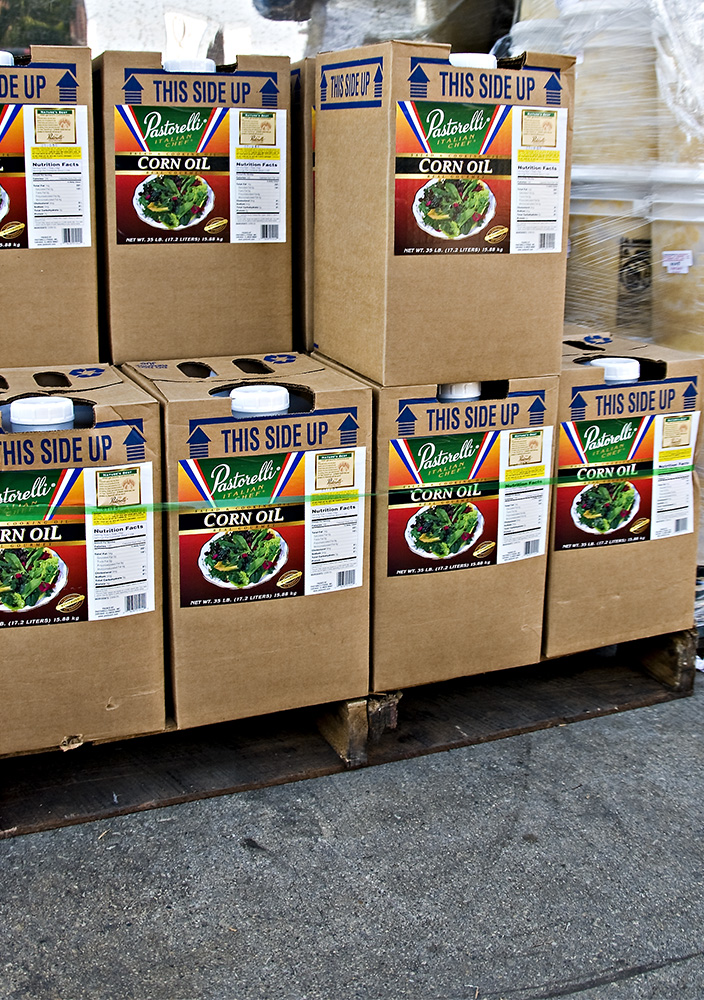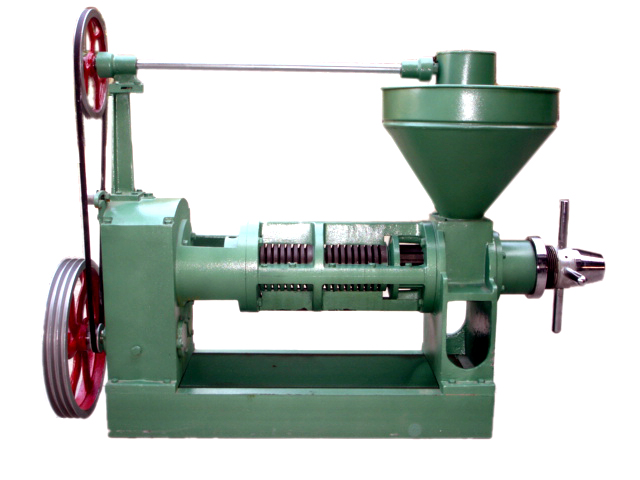|
Corn Oil
Corn oil (North American) or maize oil (British) is oil extracted from the germ of corn (maize). Its main use is in cooking, where its high smoke point makes refined corn oil a valuable frying oil. It is also a key ingredient in some margarines. Corn oil is generally less expensive than most other types of vegetable oils. Corn oil is also a feedstock used for biodiesel. Other industrial uses for corn oil include soap, salve, paint, erasers, rustproofing for metal surfaces, inks, textiles, nitroglycerin, and insecticides. It is sometimes used as a carrier for drug molecules in pharmaceutical preparations. Production Almost all corn oil is expeller-pressed, then solvent-extracted using hexane or 2-methylpentane (isohexane).Corn Refiners AssociationCorn Oil 5th Edition. 2006 The solvent is evaporated from the corn oil, recovered, and re-used. After extraction, the corn oil is then refined by degumming and/or alkali treatment, both of which remove phosphatides. Alkali tre ... [...More Info...] [...Related Items...] OR: [Wikipedia] [Google] [Baidu] |
Expeller Pressing
Expeller pressing (also called oil pressing) is a mechanical method for extracting oil from raw materials. The raw materials are squeezed under high pressure in a single step. When used for the extraction of food oils, typical raw materials are nuts, seeds and algae, which are supplied to the press in a continuous feed. As the raw material is pressed, friction causes it to heat. In the case of harder nuts, which require higher pressure, the material temperature can exceed 120 °F (49 °C). "Expeller" is a trademarked term of Anderson International Corporation since 1900, although it has become genericized, is often confused with screw press equipment in general, and does not indicate whether oil extraction is done hot or cold. Description An expeller press is a screw-type machine that mainly presses oil seeds through a caged barrel-like cavity. Some other materials processed with an expeller press include meat by-products, synthetic rubber and animal feeds. Raw mate ... [...More Info...] [...Related Items...] OR: [Wikipedia] [Google] [Baidu] |
Linoleic Acid
Linoleic acid (LA) is an organic compound with the formula . Both alkene groups () are ''cis''. It is a fatty acid sometimes denoted 18:2 (n−6) or 18:2 ''cis''-9,12. A linoleate is a salt or ester of this acid. Linoleic acid is a polyunsaturated, omega−6 fatty acid. It is a colorless liquid that is virtually insoluble in water but soluble in many organic solvents. It typically occurs in nature as a triglyceride (ester of glycerin) rather than as a free fatty acid. It is one of two essential fatty acids for humans, who must obtain it through their diet, and the most essential, because the body uses it as a base to make the others. The word "linoleic" derives , reflecting the fact that it was first isolated from linseed oil. History In 1844, F. Sacc, working at the laboratory of Justus von Liebig Justus ''Freiherr'' von Liebig (12 May 1803 – 18 April 1873) was a Germans, German scientist who made major contributions to the theory, practice, and pedagogy of che ... [...More Info...] [...Related Items...] OR: [Wikipedia] [Google] [Baidu] |
Omega-6 Fatty Acid
Omega−6 fatty acids (also referred to as ω−6 fatty acids or ''n''−6 fatty acids) are a family of polyunsaturated fatty acids (PUFA) that share a final carbon-carbon double bond in the ''n''−6 position, that is, the sixth bond, counting from the methyl end. Health and medical organizations recommend intake of omega-6 fatty acids as part of healthful dietary patterns. Health effects The American Heart Association "supports an omega-6 PUFA intake of at least 5% to 10% of energy in the context of other AHA lifestyle and dietary recommendations. To reduce omega-6 PUFA intakes from their current levels would be more likely to increase than to decrease risk for coronary heart disease." A 2018 review found that an increased intake of omega−6 fatty acids reduces total serum cholesterol and may reduce myocardial infarction (heart attack), but found no significant change in LDL cholesterol and triglycerides. A 2021 review found that omega−6 supplements do not affect the ... [...More Info...] [...Related Items...] OR: [Wikipedia] [Google] [Baidu] |
Oleic Acid
Oleic acid is a fatty acid that occurs naturally in various animal and vegetable fats and oils. It is an odorless, colorless oil, although commercial samples may be yellowish due to the presence of impurities. In chemical terms, oleic acid is classified as a monounsaturated omega-9 fatty acid, abbreviated with a lipid number of 18:1 ''cis''-9, and a main product of Δ9-desaturase. It has the formula . The name derives from the Latin word '' oleum'', which means oil. It is the most common fatty acid in nature. The salts and esters of oleic acid are called oleates. It is a common component of oils, and thus occurs in many types of food, as well as in soap. Occurrence Fatty acids (or their salts) often do not occur as such in biological systems. Instead fatty acids such as oleic acid occur as their esters, commonly triglycerides, which are the greasy materials in many natural oils. Oleic acid is the most common monounsaturated fatty acid in nature. It is found in fats (trigl ... [...More Info...] [...Related Items...] OR: [Wikipedia] [Google] [Baidu] |
Arachidic Acid
Arachidic acid, also known as icosanoic acid, is a saturated fatty acid with a 20-carbon chain. It is a minor constituent of cupuaçu butter (7%), perilla oil (0–1%), peanut oil (1.1–1.7%), corn oil (3%),U.S. Department of Agriculture, Agricultural Research Service. 2007. USDA National Nutrient Database for Standard Reference, Release 20Nutrient Data Laboratory Home Page/ref> and cocoa butter (1%). The salts and esters of arachidic acid are known as arachidates. Its name derives from the Latin ''arachis''—peanut. It can be formed by the of |
Stearic Acid
Stearic acid ( , ) is a saturated fatty acid with an 18-carbon chain. The IUPAC name is octadecanoic acid. It is a soft waxy solid with the formula . The triglyceride derived from three molecules of stearic acid is called stearin. Stearic acid is a prevalent fatty-acid in nature, found in many animal and vegetable fats, but is usually higher in animal fat than vegetable fat. It has a melting point of °C and a pKa of 4.50. Its name comes from the Greek word στέαρ "''stéar''", which means tallow. The salts and esters of stearic acid are called stearates. As its ester, stearic acid is one of the most common saturated fatty acids found in nature and in the food supply, following palmitic acid.Gunstone, F. D., John L. Harwood, and Albert J. Dijkstra "The Lipid Handbook with Cd-Rom. 3rd ed. Boca Raton: CRC Press, 2007. , Dietary sources of stearic acid include meat, poultry, fish, eggs, dairy products, and foods prepared with fats; beef tallow, lard, butterfat, ... [...More Info...] [...Related Items...] OR: [Wikipedia] [Google] [Baidu] |
Fatty Acid
In chemistry, in particular in biochemistry, a fatty acid is a carboxylic acid with an aliphatic chain, which is either saturated and unsaturated compounds#Organic chemistry, saturated or unsaturated. Most naturally occurring fatty acids have an Branched chain fatty acids, unbranched chain of an even number of carbon atoms, from 4 to 28. Fatty acids are a major component of the lipids (up to 70% by weight) in some species such as microalgae but in some other organisms are not found in their standalone form, but instead exist as three main classes of esters: triglycerides, phospholipids, and cholesteryl esters. In any of these forms, fatty acids are both important diet (nutrition), dietary sources of fuel for animals and important structural components for cell (biology), cells. History The concept of fatty acid (''acide gras'') was introduced in 1813 by Michel Eugène Chevreul, though he initially used some variant terms: ''graisse acide'' and ''acide huileux'' ("acid fat" and "oi ... [...More Info...] [...Related Items...] OR: [Wikipedia] [Google] [Baidu] |
Palmitic Acid
Palmitic acid (hexadecanoic acid in IUPAC nomenclature) is a fatty acid with a 16-carbon chain. It is the most common saturated fatty acid found in animals, plants and microorganisms.Gunstone, F. D., John L. Harwood, and Albert J. Dijkstra. The Lipid Handbook, 3rd ed. Boca Raton: CRC Press, 2007. , Its chemical formula is , and its C:D ratio (the total number of carbon atoms to the number of carbon-carbon double bonds) is 16:0. It is a major component of palm oil from the fruit of '' Elaeis guineensis'' ( oil palms), making up to 44% of total fats. Meats, cheeses, butter, and other dairy products also contain palmitic acid, amounting to 50–60% of total fats. Palmitates are the salts and esters of palmitic acid. The palmitate anion is the observed form of palmitic acid at physiologic pH (7.4). Major sources of C16:0 are palm oil, palm kernel oil, coconut oil, and milk fat. Occurrence and production Palmitic acid was discovered by saponification of palm oil, which process ... [...More Info...] [...Related Items...] OR: [Wikipedia] [Google] [Baidu] |
FAOSTAT
The Food and Agriculture Organization of the United Nations; . (FAO) is a specialized agency of the United Nations that leads international efforts to defeat hunger and improve nutrition and food security. Its Latin motto, , translates to "let there be bread". It was founded on 16 October 1945. The FAO comprises 195 members, including 194 countries and the European Union. Its headquarters is in Rome, Italy, and it maintains regional and field offices worldwide, operating in over 130 countries. It helps governments and development agencies coordinate their activities to improve and develop agriculture, forestry, fisheries, and land and water resources. It also conducts research, provides technical assistance to projects, operates educational and training programs, and collects agricultural output, production, and development data. The FAO is governed by a biennial conference representing each member country and the European Union, which elects a 49-member executive coun ... [...More Info...] [...Related Items...] OR: [Wikipedia] [Google] [Baidu] |
Winterization (of Oil)
Winterization of oil is a process that uses a solvent and cold temperatures to separate lipids and other desired oil compounds from waxes. Winterization is a type of fractionation (also known as fractionate crystallization), the general process of separating the triglycerides found in fats and oils, using the difference in their melting points, solubility, and volatility. Winterization is an oil refinement technique commonly used in biotechnology. The process involves dissolving the extract in ethanol, then placing the mixture in a freezer to chill. The cold allows for the separation of compounds by differences in their melting and precipitation points. In the cooling process, the fats and waxes with higher melting points will precipitate out and can then be removed by filtration, centrifugation, decantation, or other separation processes. A pure, liquid oil extract is left behind, ready to be further processed for consumer use. Bioindustry applications Food products containing ... [...More Info...] [...Related Items...] OR: [Wikipedia] [Google] [Baidu] |
Phospholipid
Phospholipids are a class of lipids whose molecule has a hydrophilic "head" containing a phosphate group and two hydrophobic "tails" derived from fatty acids, joined by an alcohol residue (usually a glycerol molecule). Marine phospholipids typically have omega-3 fatty acids EPA and DHA integrated as part of the phospholipid molecule. The phosphate group can be modified with simple organic molecules such as choline, ethanolamine or serine. Phospholipids are a key component of all cell membranes. They can form lipid bilayers because of their amphiphilic characteristic. In eukaryotes, cell membranes also contain another class of lipid, sterol, interspersed among the phospholipids. The combination provides fluidity in two dimensions combined with mechanical strength against rupture. Purified phospholipids are produced commercially and have found applications in nanotechnology and materials science. The first phospholipid identified in 1847 as such in biological tissues w ... [...More Info...] [...Related Items...] OR: [Wikipedia] [Google] [Baidu] |



